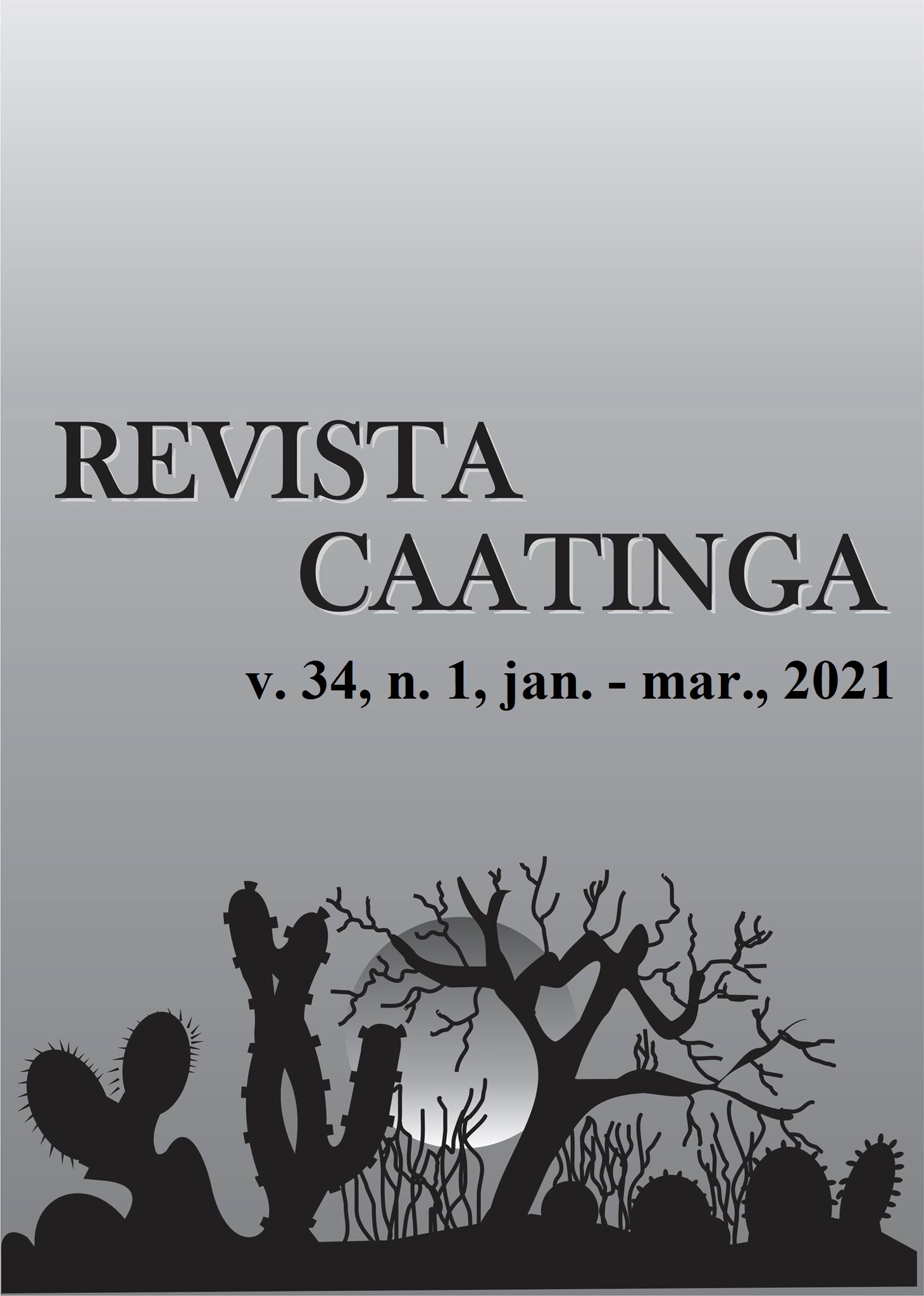PHYTOCHEMICAL AND ANTIOXIDANT COMPOSITION IN ACCESSIONS OF THE MANGABA ACTIVE GERMPLASM BANK
DOI:
https://doi.org/10.1590/1983-21252021v34n123rcKeywords:
Brazilian fruits. Phenolic compounds. Rutin. Antioxidant activity.Abstract
Mangaba (Hancornia speciosa Gomes) is a fruit species native to Brazil, belonging to the Apocynaceae family. Its cultivation is predominantly extractivist and its antioxidant properties have been recently reported. The objective of this study was to evaluate the bioactive compounds and antioxidant activity in fruits of accession from the Active Germplasm Bank of Embrapa Coastal Tablelands (BI, CA, LG, PR, PT and TC). The extracts were analyzed by high-performance liquid chromatography (HPLC), which identified chlorogenic acid (93.71 - 131.66 mg.100g-1), ferulic acid (0.85 - 2.27 mg.100g-1) and rutin (238.59 - 442.94 mg.100g-1). The accessions CA and PR showed the highest values of total phenols (1179.39 and 1167.05 mg GAE.100g-1, respectively). The accessions CA and TC had the highest concentration of the major compound rutin (436.78 and 442.94 mg.100g-1, respectively). Antioxidant activity values ranged from 125.95 to 158.67 g.g-1 DPPH. Principal component analysis grouped the accessions into four groups, due to the genetic variability verified in previous studies. The results will be useful to guide actions of selection and future breeding program of the species.
Downloads
References
ALMEIDA, M. M. B. et al. Bioactive compounds and antioxidant activity of fresh exotic fruits from northeastern Brazil. Food Research International, 44: 2155-2159, 2011.
ALVES, R. D. B. et al. Manual de curadores de germoplasma-vegetal: caracterização química de metabólitos secundários em germoplasma vegetal. Brasília: Embrapa Recursos Genéticos e Biotecnologia, 2010. 12 p.
BASTOS, K. X. et al. Identification of phenolic compounds from Hancornia speciosa (Apocynaceae) leaves by uhplc orbitrap-hrms. Molecules, 22: 143, 2017.
BECHO, J. R. M.; MACHADO, H.; OLIVEIRA, M. G. Rutina–estrutura, metabolismo e potencial farmacológico. Revista Interdisciplinar de Estudos Experimentais, 1: 21-25, 2009.
BRAND-WILLIAMS, W.; CUVELIER, M. E.; BERSET, C. L. W. T. Use of a free radical method to evaluate antioxidant activity. LWT-Food science and Technology, 28: 25-30, 1995.
COSTA, T. S. et al. Genetic diversity of accessions of the mangaba germplasm bank in Sergipe, Brazil. Pesquisa Agropecuária Brasileira, 46: 499-508, 2011.
GOMES, E. B. et al. A rapid method for determination of some phenolic acids in brazilian tropical fruits of mangaba (Hancornia speciosa Gomes) and Umbu (Spondias tuberosa Arruda Camara) by UPLC. Journal of Analytical Sciences, Methods and Instrumentation, 3: 1-10, 2013.
KRAUJALYTĖ, V. et al. Antioxidant properties and polyphenolic compositions of fruits from different European cranberrybush (Viburnum opulus L.) genotypes. Food Chemistry, 141: 3695–3702, 2013.
LIMA, J. P. et al. First evaluation of the antimutagenic effect of mangaba fruit in vivo and its phenolic profile identification. Food Research International, 75: 216–224, 2015.
MANCUSO, C.; SANTANGELO, R. Ferulic acid: Pharmacological and toxicological aspects. Food and Chemical Toxicology, 65: 185-195, 2014.
MORAES, T. M. et al. Hancornia speciosa: indications of gastroprotective, healing and anti-Helicobacter pylori actions. Journal of Ethnopharmacology, 120: 161-168, 2008.
PÉREZ-JIMÉNEZ, J.; SAURA-CALIXTO, F. Effect of solvent and certain food constituents on different antioxidant capacity assays. Food Research International, 39: 791-800, 2006.
PUUPPONEN-PIMIA, R. et al. Antimicrobial properties of phenolic compounds from berries. Journal of Applied Microbiology, 90: 494–507, 2001.
RUFINO, M. S. M. et al. Metodologia científica: determinação da atividade antioxidante total em 46 frutas pela captura do radical livre DPPH. Fortaleza, CE: Embrapa Agroindústria Tropical, 2007. 4 p. (Comunicado Técnico, 127).
RUFINO, M. S. M. et al. Bioactive compounds and antioxidant capacities of 18 non-traditional tropical fruits from Brazil. Food Chemistry, 121: 996–1002, 2010.
SANTOS, P. S. et al. Genetic diversity and the quality of mangabeira tree fruits (Hancornia speciosa Gomes–Apocynaceae), a native species from Brazil. Scientia Horticulturae, 226: 372-378, 2017.
SATO, Y. et al. In vitro and in vivo antioxidant properties of chlorogenic acid and caffeic acid. International Journal of Pharmaceutics, 403: 136–138, 2011.
SILVA, A. V. C. et al. Atributos de qualidade de funcionais de acessos do banco ativo de germoplasma de mangaba da Embrapa Tabuleiros Costeiros. Aracaju, SE: Embrapa Tabuleiros, 2015. 7 p. (Circular Técnica, 71).
SILVA JÚNIOR, J. F. A cultura da Mangaba. Revista Brasileira de Fruticultura, 26: 1-192, 2004.
SINGLETON, V. L.; ROSSI, J. A. Colorimetry of total phenolics with phosphomolybdic phosphotungstic acid reagents. American Journal of Enology and Viticulture, 16: 144-158, 1965.
SUCUPIRA, N. R. et al. Métodos para determinação da atividade antioxidante de frutos. UNOPAR Científica Ciências Biológicas e da Saúde, 14: 263-269, 2012.
VIDAL, R. F. Caracterização, compostos bioativos e atividade antioxidante de genótipos de 74 mangabeiras (Hancornia speciosa Gomes) nativos do litoral cearense. 2010. 92 f. Dissertação (Mestrado em Fitotecnia: Área de Concentração em pós-colheita) – Universidade Federal do Ceará, Fortaleza, 2010.
WANG, G. F. et al. Antihepatitis B virus activity of chlorogenic acid, quinic acid and caffeic acid in vivo and in vitro. Antiviral Research, 83: 186–190, 2009.
Downloads
Published
Issue
Section
License
Os Autores que publicam na Revista Caatinga concordam com os seguintes termos:
a) Os Autores mantêm os direitos autorais e concedem à revista o direito de primeira publicação, com o trabalho simultaneamente licenciado sob a Licença Creative Commons do tipo atribuição CC-BY, para todo o conteúdo do periódico, exceto onde estiver identificado, que permite o compartilhamento do trabalho com reconhecimento da autoria e publicação inicial nesta revista, sem fins comerciais.
b) Os Autores têm autorização para distribuição não-exclusiva da versão do trabalho publicada nesta revista (ex.: publicar em repositório institucional ou como capítulo de livro), com reconhecimento de autoria e publicação inicial nesta revista.
c) Os Autores têm permissão e são estimulados a publicar e distribuir seu trabalho online (ex.: em repositórios institucionais ou na sua página pessoal) a qualquer ponto antes ou durante o processo editorial, já que isso pode gerar alterações produtivas, bem como aumentar o impacto e a citação do trabalho publicado (Veja O Efeito do Acesso Livre).







